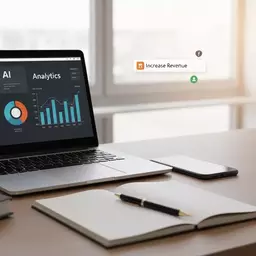Increased Engagement & Conversion
Quick responses boost customer engagement levels significantly.
Leads receiving timely responses are more likely to convert.
In a world where every second counts, the speed of your response can make or break a sale. The importance of speed-to-lead in today’s digital marketplace cannot be overstated. Here's what you can gain from understanding and implementing effective lead response strategies.
This visual highlights the critical relationship between prompt lead response and improved business outcomes, showing how quick engagement drives conversions and enhances profitability.
Quick responses boost customer engagement levels significantly.
Leads receiving timely responses are more likely to convert.
In today’s fast-paced business environment, speed-to-lead has emerged as a critical factor for revenue growth. It refers to the time taken to respond to a potential customer or lead after they express interest in your product or service. Why does this matter? Simply put, quicker responses can significantly influence the likelihood of converting leads into paying customers. It’s about being present when the customer is ready to engage!
As a business strategist, I often see small and medium-sized businesses struggling with slow response times. This delay can result in lost opportunities. In fact, research indicates that the first company to respond to a lead has a significantly higher chance of securing that lead. So, if we're not quick, we risk losing out to competitors who are!
Speed-to-lead is more than just a buzzword; it’s a metric that can drive your sales strategy. It’s crucial to understand that in our digital age, customers expect immediate responses. They are often shopping around, and if they don't hear back from you promptly, they may move on to the next option.
At My AI Business Coach, we've seen firsthand how implementing quick response strategies can transform businesses. It’s about meeting your leads where they are, when they need you!
The connection between speed-to-lead and conversion rates is undeniable. For every minute that passes without a response, the chances of conversion drop. Reports show that businesses that respond within five minutes are more likely to convert leads than those that take longer. This correlation highlights the importance of having a system in place to ensure quick follow-ups. In fact, studies demonstrate that response time directly impacts revenue, with delays significantly hindering conversion rates.
By aligning your approach to speed-to-lead with measurable outcomes, you create a pathway for growth and improved profitability.
Response rate plays a pivotal role in the efficiency of speed-to-lead. It’s not just about speed; it’s also about consistency. A prompt response is vital, but if it lacks quality or personalization, it might not resonate with the lead. This is where balancing speed with effective communication is essential. Moreover, a timely response significantly contributes to customer satisfaction, as highlighted by various reports, showing the impact of response time on customer satisfaction.
At My AI Business Coach, we advocate for a holistic approach to response rates—one that marries speed with a personal touch!
To maximize your speed-to-lead effectiveness, consider implementing an automated response system. This ensures that leads receive an immediate acknowledgment of their inquiry, even if a detailed response takes longer. Studies show that businesses employing such systems see a 30% increase in lead engagement!
Investing in speed-to-lead solutions is not just a short-term strategy; it’s a long-term commitment that can yield significant returns. As I often tell the clients at My AI Business Coach, optimizing your lead response times is about more than just immediate gains. It’s about building a sustainable foundation for your business that enhances profitability over time.
When we analyze the cost versus benefits, the numbers tell a compelling story. Faster lead responses not only increase sales but also reduce operational costs related to lead management. Here’s a simple breakdown that highlights the major factors to consider:
This clear correlation between faster response times and enhanced revenue proves that the initial investment in speed-to-lead solutions can pay dividends in the long run. By adopting these practices, businesses can see improvements in their bottom line that far exceed the initial costs incurred.
Conducting a cost-benefit analysis is vital when considering the implementation of AI in your lead response strategy. Here’s how to evaluate your potential return on investment:
By systematically analyzing these components, you can determine whether the investment aligns with your business goals. At My AI Business Coach, I often guide businesses through this process, helping them understand their unique metrics and how AI can boost their revenue.
To truly grasp the long-term impact of speed-to-lead solutions, leveraging the right tools is essential. Here are some valuable options:
Utilizing these tools allows businesses to quantify the effects of their strategies over time. By carefully monitoring key performance indicators (KPIs), companies can better understand how their investments in speed-to-lead solutions translate to financial returns.
Finally, to evaluate the effectiveness of speed-to-lead initiatives, you need to track specific performance metrics consistently. Here are the crucial metrics to keep in mind:
These metrics will not only help you gauge the effectiveness of your current strategies but also guide future improvements. At My AI Business Coach, I love seeing businesses transform when they commit to optimizing their lead responses. Remember, every moment counts in this competitive landscape!
Here is a quick recap of the important points discussed in the article:

 Have you ever wondered how artificial intelligence can reshape consumer behavior and decision-making
Have you ever wondered how artificial intelligence can reshape consumer behavior and decision-making
 As the digital landscape evolves, small businesses are discovering that artificial intelligence is n
As the digital landscape evolves, small businesses are discovering that artificial intelligence is n
 Did you know that personalized marketing can lead to a revenue increase of up to 30%? In an era wher
Did you know that personalized marketing can lead to a revenue increase of up to 30%? In an era wher
 Are you aware that reactivating dormant customers can significantly enhance your business growth? Ma
Are you aware that reactivating dormant customers can significantly enhance your business growth? Ma